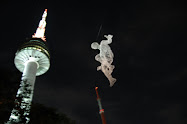“Okay…all right," I said. "The cube is heavy and dense. It’s made out of basalt. It’s seven by seven by seven. It’s black and it’s wedged into the sand, like buried halfway up, like it fell from the sky.”
“Good. Okay, now, describe a ladder.”
“Right. All right, the cube is in the foreground, the ladder is in the middle ground, and it’s a steel step-ladder, tall enough to perfectly frame the cube if you look at it right, from far enough away…the cube sits in the triangle it makes?”
“Okay. Now, a horse.”
“All right, it’s a palomino. It’s off in the distance on the horizon and it’s walking away. It’s a spec of dust. It’s too far away to hear you. You can’t call to it—-it won’t save you.”
“Okay…that’s it. That’s good.” She smiled and looked at the space around our feet. “Now do you want to hear what they mean?”
“I knew it. I knew this ‘meant’ something. That’s why I didn’t want to do it.”
“Well, the cube is good. It’s you—-what you think about yourself. The ladder is your family. And the horse,” she laughed, “the horse is love.”
“I told you what I think about that.”
“I know you did.”
We were sitting on wood benches under a canopy of overgrown vines draped over the edges. She sat across from me; we weren’t touching.
It must have been good once. We had left her apartment for a walk and saw a sign hanging over the center of the street—-Dreamland—-and followed it. We followed the signs for miles. As we walked we talked about the possibilities—-with a name like that—-for greatness.
“I bet the whole place is one giant cloud.”
“Isn’t this the same as heaven? Isn’t that what heaven’s supposed to be—-dreamland? Are we going to heaven?”
We walked up the sidewalk, past heaps of piled up trash on the street corners, under ginko biloba trees, smelling the grilled beef galbi restaurants, until we saw the gates at the end of the street.
Before the entrance a parking lot—-in the parking lot two cars. Inside the gate we came upon a place, frozen. In the air the still echoes of a once happy park. A spot where families would come with full vans, where the children would—-not hearing their parents’ words of waiting—-leap from the car and run to stand in lines. Where those same children would remind themselves to brag to their friends at school on Monday. Now, the muffled noises of unseen children, now, the faint sounds the whispers of wishes.
An Italian carousel spun for a boy. He sat in a teacup, with his knees wrapped around the center wheel, tongue out of the corner of his mouth, bent in determination, hands working to make the cup spin. No workers, no people—-only the spinning boy.
We held hands. We gave the carousel a wide berth and on the other side found an arcade. Most of the games were turned on and in the corner a man and his son played a gun game. They stopped laughing when they saw us. The park led us past the closed doors of an aquarium, where the paint on a killer whale flaked under the white spot, giving him a grey eye. We walked past a cage of tom turkeys and baboons. The turkeys didn’t recognize us but the baboons clung to the face of the cage and followed us with their eyes.
“This would be a good place to shoot a horror movie.”
On one edge a small forest. We opened a short wooden gate. An overgrown path led us up and out of the concrete. At the end of the path a lone tree lay felled, dead, in a clearing. For a moment we felt as though we were alone in nature—-surrounded on all sides by grass and bushes and magpies talking in the tops of the trees.
We walked in circles around the dead tree. It was here she started talking about the cube. We still had time left on our tickets, so we went on to the back of the park, where we passed a family that would not look at us. We stopped to look at the mural painted behind one of the rides. It had likenesses of famous American musicians and some men and women painted badly enough to appear monstrous. Maybe the bad painting scared the people away. But no, that wasn’t it. At the place where we sat and talked a yellow and red spider waited in the center of a web. It had a warrior face painted on its back.
The mosquitoes that the spider couldn’t catch drove us out. We took another way back, to the center, where we walked into the blue glow of an empty swimming pool. It stretched away from our feet. It would have been good for skateboards—-long rides to the end.
“I like the color.”
I smelled decaying suntan lotion and heard murmurs of splashing, of children’s feet running through, though their parents had told them not to. I saw a game where they dropped a baekwon in the deep end and dove for it. We left the pool and walked down a grass hill to the gate.
“Do you want to hear mine?”
“Sure.”
“Mine was a Rubik’s cube, unsolved. The ladder was a wooden ladder, laying in the sand, and my horse, my horse was great. It was a pink pony prancing.”























